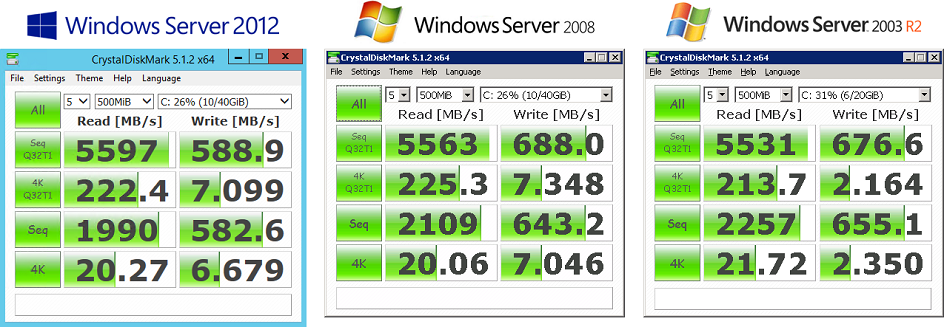Windows Server 2012, 2008 and 2003: Tests of Available System Performance
On Monday, August 29, due to numerous requests from our customers, we added the ability to select outdated operating systems for installation on UltraVDS virtual servers . The reasons why interest arises in past-generation operating systems are completely different: the power of habit, the specific requirements of a software developer, or even lower resource consumption.
The reason for choosing an OS that consumes less virtual server resources is quite understandable: it is not very pleasant to pay to “feed” a modern operating system, while its advanced functionality is not used.
In this article, we decided to consider how much additional resources can be obtained (and whether it is possible at all) if you install an outdated OS on a leased VDS server .
')
The test involved 64-bit operating systems:
We installed all these operating systems on identical virtual servers of the premium tariff plan with the configuration: 2 CPU cores, 2GB RAM and 40GB HDD.
Using the software " PerformanceTest ", we conducted 5 tests measuring the performance of the processor with an interval of 1 hour each:
The table shows the total result of floating point CPU performance (CPU Floating Point Math). Test duration in software settings: Very Long. The priority of processes has not changed to ensure an optimal result for the User Experience.

From the results it can be seen that immediately after the creation of the server, the available system performance for client tasks is the lowest on Windows Server 2012 and the highest on Windows Server 2003. This is due to the fact that after installation, for some time, Win 2012 and Win 2008 “eat up” system resources for optimization of further work of their modules, but after 10-15 minutes resources are released to the full use of the client. Because of this effect, it may seem that new OSs require significantly more resources for their work, however, as the test has shown, this is not true.
Then, using the CrystalDiskMark software, the performance of the disk system was measured, with the following results:

In any version of Windows Server, the same disk performance is available for the client.
According to the test results, we can definitely say that you should not choose outdated operating systems based on the principle of saving resources - the available performance is almost identical in any OS versions . Along with this, more modern versions will provide greater security, reliability and functionality of your VPS server .
PS: the latest server operating system from Microsoft will be released very soon: Windows Server 2016 , a licensed copy of which UltraVDS will be one of the first to provide for the use of its customers!
The reason for choosing an OS that consumes less virtual server resources is quite understandable: it is not very pleasant to pay to “feed” a modern operating system, while its advanced functionality is not used.
In this article, we decided to consider how much additional resources can be obtained (and whether it is possible at all) if you install an outdated OS on a leased VDS server .
')
The test involved 64-bit operating systems:
- Windows Server 2012 R2
- Windows Server 2008 R2 SP1
- Windows Server 2003 R2 SP2
We installed all these operating systems on identical virtual servers of the premium tariff plan with the configuration: 2 CPU cores, 2GB RAM and 40GB HDD.
Using the software " PerformanceTest ", we conducted 5 tests measuring the performance of the processor with an interval of 1 hour each:
| operating system | Test 1 | Test 2 | Test 3 | Test 4 | Test 5 |
|---|---|---|---|---|---|
| Windows Server 2012 R2 | 2438 | 3392 | 3543 | 3673 | 3526 |
| Windows Server 2008 R2 SP1 | 3078 | 3536 | 3384 | 3634 | 3413 |
| Windows Server 2003 R2 SP2 | 3531 | 3448 | 3454 | 3529 | 3450 |

From the results it can be seen that immediately after the creation of the server, the available system performance for client tasks is the lowest on Windows Server 2012 and the highest on Windows Server 2003. This is due to the fact that after installation, for some time, Win 2012 and Win 2008 “eat up” system resources for optimization of further work of their modules, but after 10-15 minutes resources are released to the full use of the client. Because of this effect, it may seem that new OSs require significantly more resources for their work, however, as the test has shown, this is not true.
Then, using the CrystalDiskMark software, the performance of the disk system was measured, with the following results:

In any version of Windows Server, the same disk performance is available for the client.
According to the test results, we can definitely say that you should not choose outdated operating systems based on the principle of saving resources - the available performance is almost identical in any OS versions . Along with this, more modern versions will provide greater security, reliability and functionality of your VPS server .
PS: the latest server operating system from Microsoft will be released very soon: Windows Server 2016 , a licensed copy of which UltraVDS will be one of the first to provide for the use of its customers!
Source: https://habr.com/ru/post/308778/
All Articles